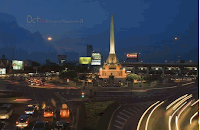
 Thailand is a country located in the centre of mainland Southeast Asia. Its area of 198,115 square miles (513,115 square kilometres) consists of two broad geographic areas: a larger section in the north and a smaller peninsular section in the south. The main body of the country is surrounded by Myanmar (Burma) to the west, Laos to the north and east, Cambodia to the southeast, and the Gulf of Thailand (Gulf of Siam) to the south. Peninsular Thailand stretches southward from the southwestern corner down the Malay Peninsula; Myanmar extends along the western portion of the peninsula as far as the Isthmus of Kra, after which Thailand occupies the entire peninsula until reaching its southern border with Malaysia at roughly latitude 6?? Bangkok, Thailand's capital and chief port, is in the main portion at the head of the Gulf of Thailand. The country was officially called Siam until 1939 and again briefly in 1945-48. The several ethnic and religious groups represented among Thailand's people are characteristic of the cultural diversity that for centuries has spread southward from China and eastward from India. Indeed, the name "Thai" to describe the country's people came into use only in the 20th century. Here we present a map of Thailand and a map of Bangkok, capital of Thailand, for your easy reference. Click each map to see a larger, more detailed version. The map below shows the central part of Bangkok. Metropolitan Bangkok consists of a very large area and cannot be covered by a single map.
Thailand is a country located in the centre of mainland Southeast Asia. Its area of 198,115 square miles (513,115 square kilometres) consists of two broad geographic areas: a larger section in the north and a smaller peninsular section in the south. The main body of the country is surrounded by Myanmar (Burma) to the west, Laos to the north and east, Cambodia to the southeast, and the Gulf of Thailand (Gulf of Siam) to the south. Peninsular Thailand stretches southward from the southwestern corner down the Malay Peninsula; Myanmar extends along the western portion of the peninsula as far as the Isthmus of Kra, after which Thailand occupies the entire peninsula until reaching its southern border with Malaysia at roughly latitude 6?? Bangkok, Thailand's capital and chief port, is in the main portion at the head of the Gulf of Thailand. The country was officially called Siam until 1939 and again briefly in 1945-48. The several ethnic and religious groups represented among Thailand's people are characteristic of the cultural diversity that for centuries has spread southward from China and eastward from India. Indeed, the name "Thai" to describe the country's people came into use only in the 20th century. Here we present a map of Thailand and a map of Bangkok, capital of Thailand, for your easy reference. Click each map to see a larger, more detailed version. The map below shows the central part of Bangkok. Metropolitan Bangkok consists of a very large area and cannot be covered by a single map.Visit Bangkok
 Bangkok is the capital and chief port of Thailand. It is the only cosmopolitan city in a country of small towns and villages and is Thailand's cultural and commercial centre. Bangkok is located on the delta of the Chao Phraya River, about 25 miles (40 kilometres) from the Gulf of Thailand. It was formerly divided into two municipalities--Krung Thep on the east bank and Thon Buri on the west--connected by several bridges. In 1971 the two were united as a city-province with a single municipal government. In 1972 the city and the two surrounding provinces were merged into one province, called Krung Thep Maha Nakhon (Bangkok Metropolis).
Bangkok is the capital and chief port of Thailand. It is the only cosmopolitan city in a country of small towns and villages and is Thailand's cultural and commercial centre. Bangkok is located on the delta of the Chao Phraya River, about 25 miles (40 kilometres) from the Gulf of Thailand. It was formerly divided into two municipalities--Krung Thep on the east bank and Thon Buri on the west--connected by several bridges. In 1971 the two were united as a city-province with a single municipal government. In 1972 the city and the two surrounding provinces were merged into one province, called Krung Thep Maha Nakhon (Bangkok Metropolis). Today, Bangkok Metropolis has a total area of 604 square miles (1,565 square kilometres). It is a bustling, crowded city, with temples, factories, shops, and homes juxtaposed along its roads The Grand Palace in Bangkok, where the former Royal Family used to live many years ago. Beside the Grand Palace is the Emerald Buddha Temple, one of the most famous Buddhist temples in Asia. This is a "must see" site for all Thai citizens as well as visitors from abroad. Come visit us this year to experience and enjoy the one and only Amazing Thailand for yourself. You will not be disappointed.
Today, Bangkok Metropolis has a total area of 604 square miles (1,565 square kilometres). It is a bustling, crowded city, with temples, factories, shops, and homes juxtaposed along its roads The Grand Palace in Bangkok, where the former Royal Family used to live many years ago. Beside the Grand Palace is the Emerald Buddha Temple, one of the most famous Buddhist temples in Asia. This is a "must see" site for all Thai citizens as well as visitors from abroad. Come visit us this year to experience and enjoy the one and only Amazing Thailand for yourself. You will not be disappointed.





























































